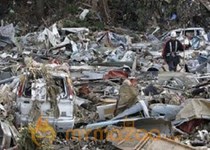The devastating earthquake followed by a tsunami that hit northeastern Japan is likely to claim over 10,000 lives, police said, as authorities scrambled Sunday to minimise the effects of possible radiation leaks from the Fukushima nuclear power plant.According to Xinhua, police said Sunday the toll is likely to cross more than 10,000.
The death toll will surely top that figure in the worst-hit prefecture of Miyagi alone, Naoto Takeuchi, chief of the prefectural police, said.
Friday afternoon’s massive 9-magnitude trembler set off huge tsunami waves that rushed ashore for kilometres along the northeastern coast, sweeping off everything in their path – buildings, cars, ships and people.
Police said earlier that more than 2,000 people had been killed or were unaccounted for in the affected regions, DPA reported, citing the Kyodo News agency.
The quake also damaged several nuclear power plants in the country.
A hydrogen explosion is possible at the No. 3 reactor of Japan’s Fukushima I nuclear power plant, Chief Cabinet Secretary Yukio Edano said Sunday.
However, he said the reactor could resist the possible blast, Xinhua reported. An explosion took place Saturday at the plant in which four people were injured.
Earlier, radiation levels surpassed legal limits at the Fukushima I plant in northeastern Japan, officials said, raising concerns over radiation leaks.
Radiation at the Fukushima I plant was at 882 microsievert per hour and briefly topped 1,204 microsievert, top government spokesman Yukio Edano said.
According to DPA, nuclear reactors at the Fukushima I and II plants lost their cooling functions after power and backup generators were cut off due after the quake, operator Tokyo Electric Power Co. (TEPCO) said.
Engineers were in the process Sunday of releasing another dose of radioactive steam from a second reactor into the atmosphere, Edano said.
The technicians were working to prevent a meltdown of the reactor. According to Japanese news reports, the cooling water in the reactor has decreased so much that up to three metres of the fuel rods were exposed.
Fresh water has been injected into the cooling system of the number 3 reactor, Edano said. Radiation levels at that reactor were “very small and under control”, Edano said.
TEPCO notified Japan’s Nuclear and Industrial Safety Agency early Sunday that reactor number 3 had lost its cooling functions, making it the sixth reactor to do so since the quake hit.
Some 200,000 people have been evacuated from a 20-km safety zone around the two plants, located 240 km north of Tokyo.
At least 19 people have been exposed to radioactivity, Kyodo said
A municipal official in Futaba town in Fukushima said that about 90 percent of the houses in three coastal communities had been washed away by the tsunami.
About 390,000 people have fled their homes, many of them finding a place to stay at the more than 1,400 emergency shelters set up in schools and community centres, broadcaster NHK said.
Meanwhile, Prime Minister Naoto Kan doubled the number of soldiers sent to the affected region to 100,000 as rescue workers were struggling to reach quake-hit areas with many roads blocked by debris.
“I ask for utmost efforts to save the lives of as many people as possible,” Kyodo quoted Kan as saying after a meeting of the government’s emergency disaster headquarters. “We will put all-out efforts into rescuing people who have been isolated.”
Drinking water was transported to quake-hit regions by truck, and witnesses said residents were rushing to stock up on supplies at supermarkets and petrol stations, buying food and heating oil.
Railway links to the quake-hit regions are to remain closed, Japan Rail said, but it resumed operations in the Tokyo metropolitan area. Highways were also closed.
On Sunday, an earthquake measuring 6.0 on the Richter scale jolted off the east coast of Honshu island, Japan, according to the China Earthquake Network Centre.







